Financial Management: Dividend Policy and Merger and Acquisition
VerifiedAdded on 2023/01/12
|12
|3864
|69
AI Summary
This article discusses the size of annual dividends, practical issues in deciding the size of dividends, the effect of different dividend options, and the impact of company decisions on investment opportunities. It also covers the price earnings ratio and dividend valuation model in the context of merger and acquisition.
Contribute Materials
Your contribution can guide someone’s learning journey. Share your
documents today.

Financial Management
Secure Best Marks with AI Grader
Need help grading? Try our AI Grader for instant feedback on your assignments.
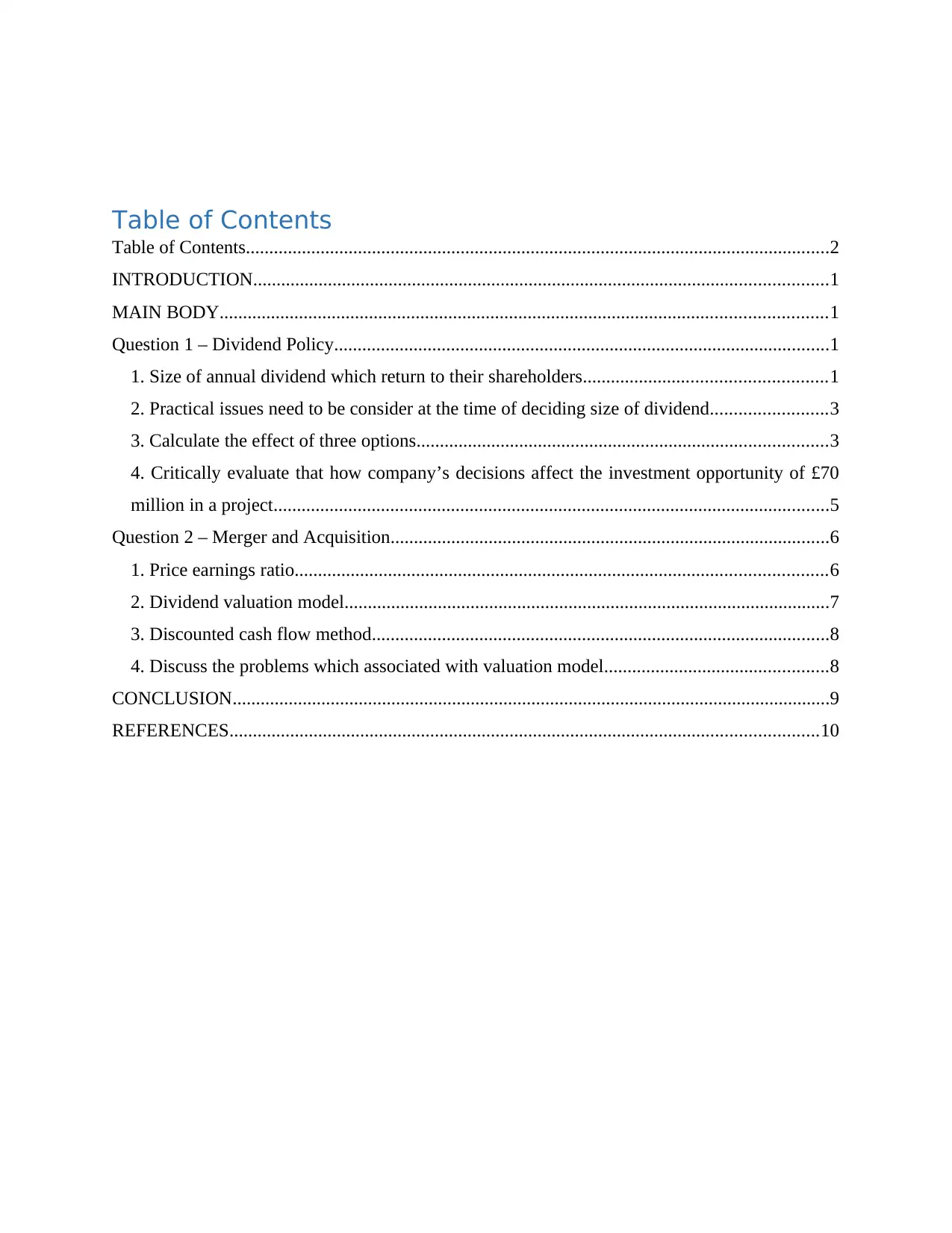
Table of Contents
Table of Contents.............................................................................................................................2
INTRODUCTION...........................................................................................................................1
MAIN BODY..................................................................................................................................1
Question 1 – Dividend Policy..........................................................................................................1
1. Size of annual dividend which return to their shareholders....................................................1
2. Practical issues need to be consider at the time of deciding size of dividend.........................3
3. Calculate the effect of three options........................................................................................3
4. Critically evaluate that how company’s decisions affect the investment opportunity of £70
million in a project.......................................................................................................................5
Question 2 – Merger and Acquisition..............................................................................................6
1. Price earnings ratio..................................................................................................................6
2. Dividend valuation model........................................................................................................7
3. Discounted cash flow method..................................................................................................8
4. Discuss the problems which associated with valuation model................................................8
CONCLUSION................................................................................................................................9
REFERENCES..............................................................................................................................10
Table of Contents.............................................................................................................................2
INTRODUCTION...........................................................................................................................1
MAIN BODY..................................................................................................................................1
Question 1 – Dividend Policy..........................................................................................................1
1. Size of annual dividend which return to their shareholders....................................................1
2. Practical issues need to be consider at the time of deciding size of dividend.........................3
3. Calculate the effect of three options........................................................................................3
4. Critically evaluate that how company’s decisions affect the investment opportunity of £70
million in a project.......................................................................................................................5
Question 2 – Merger and Acquisition..............................................................................................6
1. Price earnings ratio..................................................................................................................6
2. Dividend valuation model........................................................................................................7
3. Discounted cash flow method..................................................................................................8
4. Discuss the problems which associated with valuation model................................................8
CONCLUSION................................................................................................................................9
REFERENCES..............................................................................................................................10
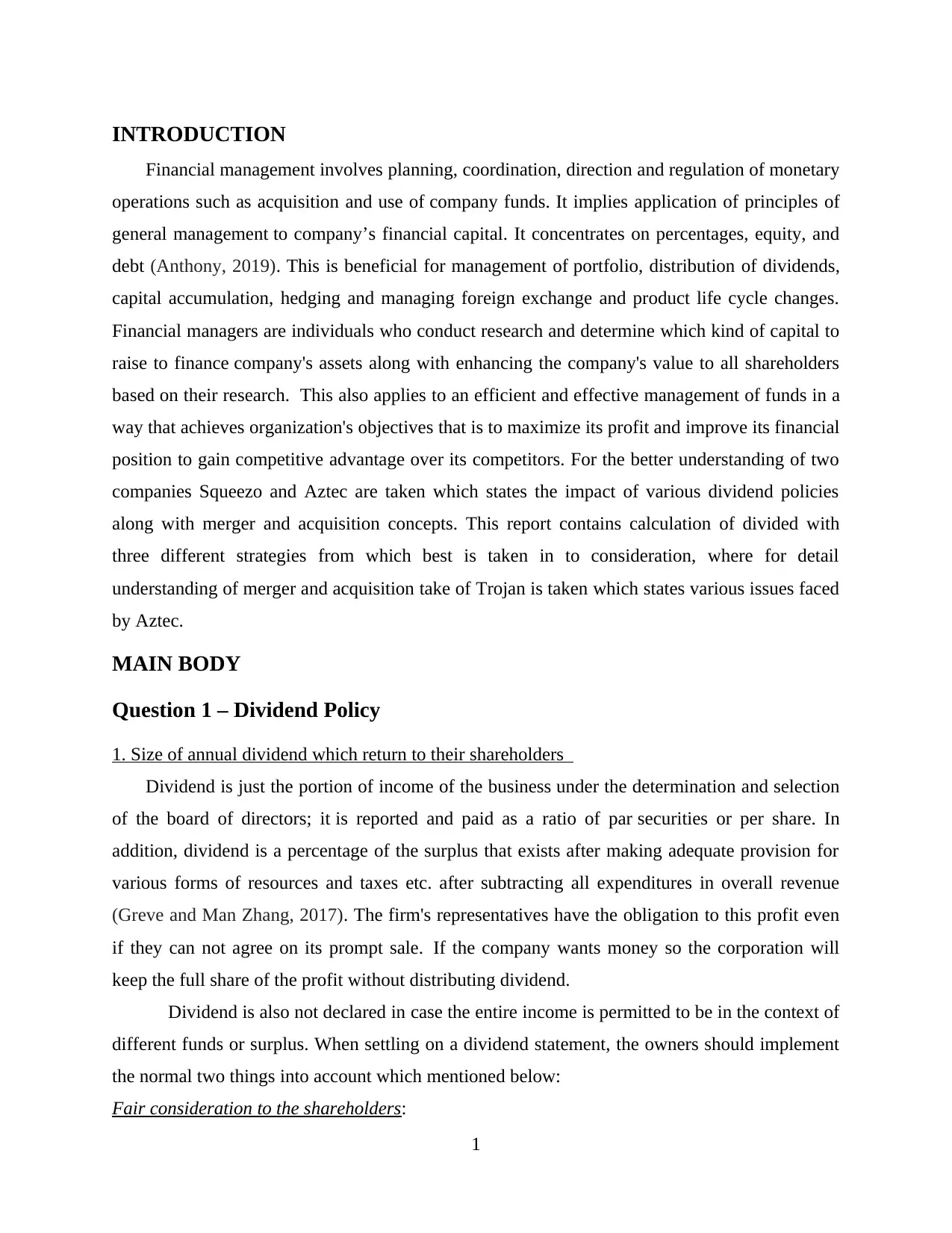
INTRODUCTION
Financial management involves planning, coordination, direction and regulation of monetary
operations such as acquisition and use of company funds. It implies application of principles of
general management to company’s financial capital. It concentrates on percentages, equity, and
debt (Anthony, 2019). This is beneficial for management of portfolio, distribution of dividends,
capital accumulation, hedging and managing foreign exchange and product life cycle changes.
Financial managers are individuals who conduct research and determine which kind of capital to
raise to finance company's assets along with enhancing the company's value to all shareholders
based on their research. This also applies to an efficient and effective management of funds in a
way that achieves organization's objectives that is to maximize its profit and improve its financial
position to gain competitive advantage over its competitors. For the better understanding of two
companies Squeezo and Aztec are taken which states the impact of various dividend policies
along with merger and acquisition concepts. This report contains calculation of divided with
three different strategies from which best is taken in to consideration, where for detail
understanding of merger and acquisition take of Trojan is taken which states various issues faced
by Aztec.
MAIN BODY
Question 1 – Dividend Policy
1. Size of annual dividend which return to their shareholders
Dividend is just the portion of income of the business under the determination and selection
of the board of directors; it is reported and paid as a ratio of par securities or per share. In
addition, dividend is a percentage of the surplus that exists after making adequate provision for
various forms of resources and taxes etc. after subtracting all expenditures in overall revenue
(Greve and Man Zhang, 2017). The firm's representatives have the obligation to this profit even
if they can not agree on its prompt sale. If the company wants money so the corporation will
keep the full share of the profit without distributing dividend.
Dividend is also not declared in case the entire income is permitted to be in the context of
different funds or surplus. When settling on a dividend statement, the owners should implement
the normal two things into account which mentioned below:
Fair consideration to the shareholders:
1
Financial management involves planning, coordination, direction and regulation of monetary
operations such as acquisition and use of company funds. It implies application of principles of
general management to company’s financial capital. It concentrates on percentages, equity, and
debt (Anthony, 2019). This is beneficial for management of portfolio, distribution of dividends,
capital accumulation, hedging and managing foreign exchange and product life cycle changes.
Financial managers are individuals who conduct research and determine which kind of capital to
raise to finance company's assets along with enhancing the company's value to all shareholders
based on their research. This also applies to an efficient and effective management of funds in a
way that achieves organization's objectives that is to maximize its profit and improve its financial
position to gain competitive advantage over its competitors. For the better understanding of two
companies Squeezo and Aztec are taken which states the impact of various dividend policies
along with merger and acquisition concepts. This report contains calculation of divided with
three different strategies from which best is taken in to consideration, where for detail
understanding of merger and acquisition take of Trojan is taken which states various issues faced
by Aztec.
MAIN BODY
Question 1 – Dividend Policy
1. Size of annual dividend which return to their shareholders
Dividend is just the portion of income of the business under the determination and selection
of the board of directors; it is reported and paid as a ratio of par securities or per share. In
addition, dividend is a percentage of the surplus that exists after making adequate provision for
various forms of resources and taxes etc. after subtracting all expenditures in overall revenue
(Greve and Man Zhang, 2017). The firm's representatives have the obligation to this profit even
if they can not agree on its prompt sale. If the company wants money so the corporation will
keep the full share of the profit without distributing dividend.
Dividend is also not declared in case the entire income is permitted to be in the context of
different funds or surplus. When settling on a dividend statement, the owners should implement
the normal two things into account which mentioned below:
Fair consideration to the shareholders:
1
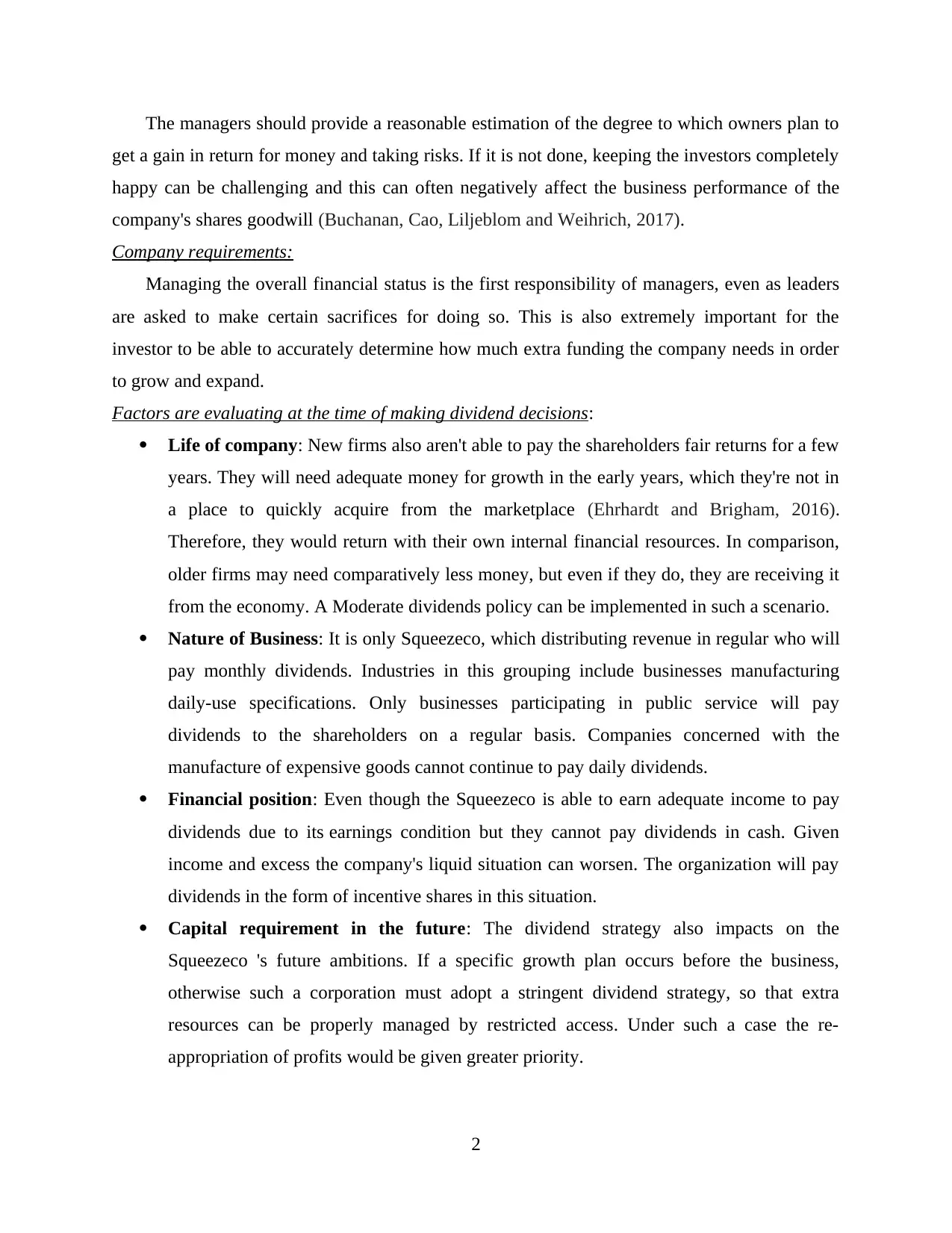
The managers should provide a reasonable estimation of the degree to which owners plan to
get a gain in return for money and taking risks. If it is not done, keeping the investors completely
happy can be challenging and this can often negatively affect the business performance of the
company's shares goodwill (Buchanan, Cao, Liljeblom and Weihrich, 2017).
Company requirements:
Managing the overall financial status is the first responsibility of managers, even as leaders
are asked to make certain sacrifices for doing so. This is also extremely important for the
investor to be able to accurately determine how much extra funding the company needs in order
to grow and expand.
Factors are evaluating at the time of making dividend decisions:
Life of company: New firms also aren't able to pay the shareholders fair returns for a few
years. They will need adequate money for growth in the early years, which they're not in
a place to quickly acquire from the marketplace (Ehrhardt and Brigham, 2016).
Therefore, they would return with their own internal financial resources. In comparison,
older firms may need comparatively less money, but even if they do, they are receiving it
from the economy. A Moderate dividends policy can be implemented in such a scenario.
Nature of Business: It is only Squeezeco, which distributing revenue in regular who will
pay monthly dividends. Industries in this grouping include businesses manufacturing
daily-use specifications. Only businesses participating in public service will pay
dividends to the shareholders on a regular basis. Companies concerned with the
manufacture of expensive goods cannot continue to pay daily dividends.
Financial position: Even though the Squeezeco is able to earn adequate income to pay
dividends due to its earnings condition but they cannot pay dividends in cash. Given
income and excess the company's liquid situation can worsen. The organization will pay
dividends in the form of incentive shares in this situation.
Capital requirement in the future: The dividend strategy also impacts on the
Squeezeco 's future ambitions. If a specific growth plan occurs before the business,
otherwise such a corporation must adopt a stringent dividend strategy, so that extra
resources can be properly managed by restricted access. Under such a case the re-
appropriation of profits would be given greater priority.
2
get a gain in return for money and taking risks. If it is not done, keeping the investors completely
happy can be challenging and this can often negatively affect the business performance of the
company's shares goodwill (Buchanan, Cao, Liljeblom and Weihrich, 2017).
Company requirements:
Managing the overall financial status is the first responsibility of managers, even as leaders
are asked to make certain sacrifices for doing so. This is also extremely important for the
investor to be able to accurately determine how much extra funding the company needs in order
to grow and expand.
Factors are evaluating at the time of making dividend decisions:
Life of company: New firms also aren't able to pay the shareholders fair returns for a few
years. They will need adequate money for growth in the early years, which they're not in
a place to quickly acquire from the marketplace (Ehrhardt and Brigham, 2016).
Therefore, they would return with their own internal financial resources. In comparison,
older firms may need comparatively less money, but even if they do, they are receiving it
from the economy. A Moderate dividends policy can be implemented in such a scenario.
Nature of Business: It is only Squeezeco, which distributing revenue in regular who will
pay monthly dividends. Industries in this grouping include businesses manufacturing
daily-use specifications. Only businesses participating in public service will pay
dividends to the shareholders on a regular basis. Companies concerned with the
manufacture of expensive goods cannot continue to pay daily dividends.
Financial position: Even though the Squeezeco is able to earn adequate income to pay
dividends due to its earnings condition but they cannot pay dividends in cash. Given
income and excess the company's liquid situation can worsen. The organization will pay
dividends in the form of incentive shares in this situation.
Capital requirement in the future: The dividend strategy also impacts on the
Squeezeco 's future ambitions. If a specific growth plan occurs before the business,
otherwise such a corporation must adopt a stringent dividend strategy, so that extra
resources can be properly managed by restricted access. Under such a case the re-
appropriation of profits would be given greater priority.
2
Secure Best Marks with AI Grader
Need help grading? Try our AI Grader for instant feedback on your assignments.
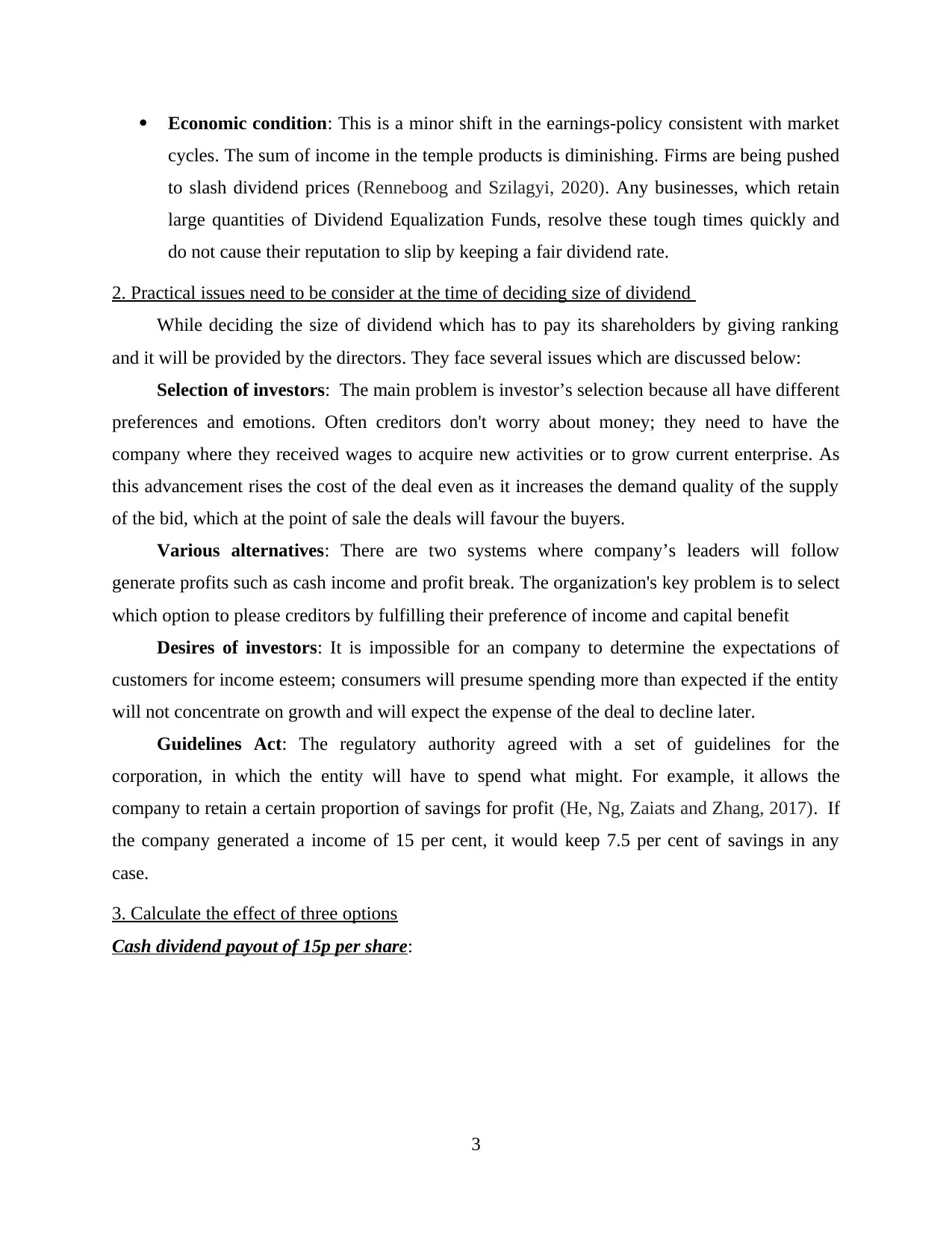
Economic condition: This is a minor shift in the earnings-policy consistent with market
cycles. The sum of income in the temple products is diminishing. Firms are being pushed
to slash dividend prices (Renneboog and Szilagyi, 2020). Any businesses, which retain
large quantities of Dividend Equalization Funds, resolve these tough times quickly and
do not cause their reputation to slip by keeping a fair dividend rate.
2. Practical issues need to be consider at the time of deciding size of dividend
While deciding the size of dividend which has to pay its shareholders by giving ranking
and it will be provided by the directors. They face several issues which are discussed below:
Selection of investors: The main problem is investor’s selection because all have different
preferences and emotions. Often creditors don't worry about money; they need to have the
company where they received wages to acquire new activities or to grow current enterprise. As
this advancement rises the cost of the deal even as it increases the demand quality of the supply
of the bid, which at the point of sale the deals will favour the buyers.
Various alternatives: There are two systems where company’s leaders will follow
generate profits such as cash income and profit break. The organization's key problem is to select
which option to please creditors by fulfilling their preference of income and capital benefit
Desires of investors: It is impossible for an company to determine the expectations of
customers for income esteem; consumers will presume spending more than expected if the entity
will not concentrate on growth and will expect the expense of the deal to decline later.
Guidelines Act: The regulatory authority agreed with a set of guidelines for the
corporation, in which the entity will have to spend what might. For example, it allows the
company to retain a certain proportion of savings for profit (He, Ng, Zaiats and Zhang, 2017). If
the company generated a income of 15 per cent, it would keep 7.5 per cent of savings in any
case.
3. Calculate the effect of three options
Cash dividend payout of 15p per share:
3
cycles. The sum of income in the temple products is diminishing. Firms are being pushed
to slash dividend prices (Renneboog and Szilagyi, 2020). Any businesses, which retain
large quantities of Dividend Equalization Funds, resolve these tough times quickly and
do not cause their reputation to slip by keeping a fair dividend rate.
2. Practical issues need to be consider at the time of deciding size of dividend
While deciding the size of dividend which has to pay its shareholders by giving ranking
and it will be provided by the directors. They face several issues which are discussed below:
Selection of investors: The main problem is investor’s selection because all have different
preferences and emotions. Often creditors don't worry about money; they need to have the
company where they received wages to acquire new activities or to grow current enterprise. As
this advancement rises the cost of the deal even as it increases the demand quality of the supply
of the bid, which at the point of sale the deals will favour the buyers.
Various alternatives: There are two systems where company’s leaders will follow
generate profits such as cash income and profit break. The organization's key problem is to select
which option to please creditors by fulfilling their preference of income and capital benefit
Desires of investors: It is impossible for an company to determine the expectations of
customers for income esteem; consumers will presume spending more than expected if the entity
will not concentrate on growth and will expect the expense of the deal to decline later.
Guidelines Act: The regulatory authority agreed with a set of guidelines for the
corporation, in which the entity will have to spend what might. For example, it allows the
company to retain a certain proportion of savings for profit (He, Ng, Zaiats and Zhang, 2017). If
the company generated a income of 15 per cent, it would keep 7.5 per cent of savings in any
case.
3. Calculate the effect of three options
Cash dividend payout of 15p per share:
3

Cash Dividend: It means a dividend which is paid in cash / bank to investors (Setiawan,
Bandi, Phua and Trinugroho, 2016). If a company has no funds to pay dividends so they pays
dividends in the form of bonds or they may claim the owner to given extra stock in the company.
The word is considered as stock dividend.
Interpretation: Above table represent that total outstanding shares are 1250 that are
needed to achieve revenues; the cash reward here is the option made to produce profits. That's
why; the all-out capital benefit is £187.5 per client, at 15p.
5% Scrip Dividend:
Rather than charging shareholders cash dividends, the corporation is selling current
shareholders new shares of the company previously determined (Moortgat, Annaert and Deloof,
2017). It encourages buyers to enter the system in order to buy additional securities without the
acquisition expenses usually charged when these securities were bought on the market. Cash
funds are the main reason for the company's payment of scrip dividends because it is profitable
tactic for a company. Calculation of total dividend mentioned in the below table:
Interpretation: From the above calculation, it is analysed that outstanding shares are
1250 where 5% percentage is drawn from all outstanding deals as all remaining earnings, which
4
Bandi, Phua and Trinugroho, 2016). If a company has no funds to pay dividends so they pays
dividends in the form of bonds or they may claim the owner to given extra stock in the company.
The word is considered as stock dividend.
Interpretation: Above table represent that total outstanding shares are 1250 that are
needed to achieve revenues; the cash reward here is the option made to produce profits. That's
why; the all-out capital benefit is £187.5 per client, at 15p.
5% Scrip Dividend:
Rather than charging shareholders cash dividends, the corporation is selling current
shareholders new shares of the company previously determined (Moortgat, Annaert and Deloof,
2017). It encourages buyers to enter the system in order to buy additional securities without the
acquisition expenses usually charged when these securities were bought on the market. Cash
funds are the main reason for the company's payment of scrip dividends because it is profitable
tactic for a company. Calculation of total dividend mentioned in the below table:
Interpretation: From the above calculation, it is analysed that outstanding shares are
1250 where 5% percentage is drawn from all outstanding deals as all remaining earnings, which
4
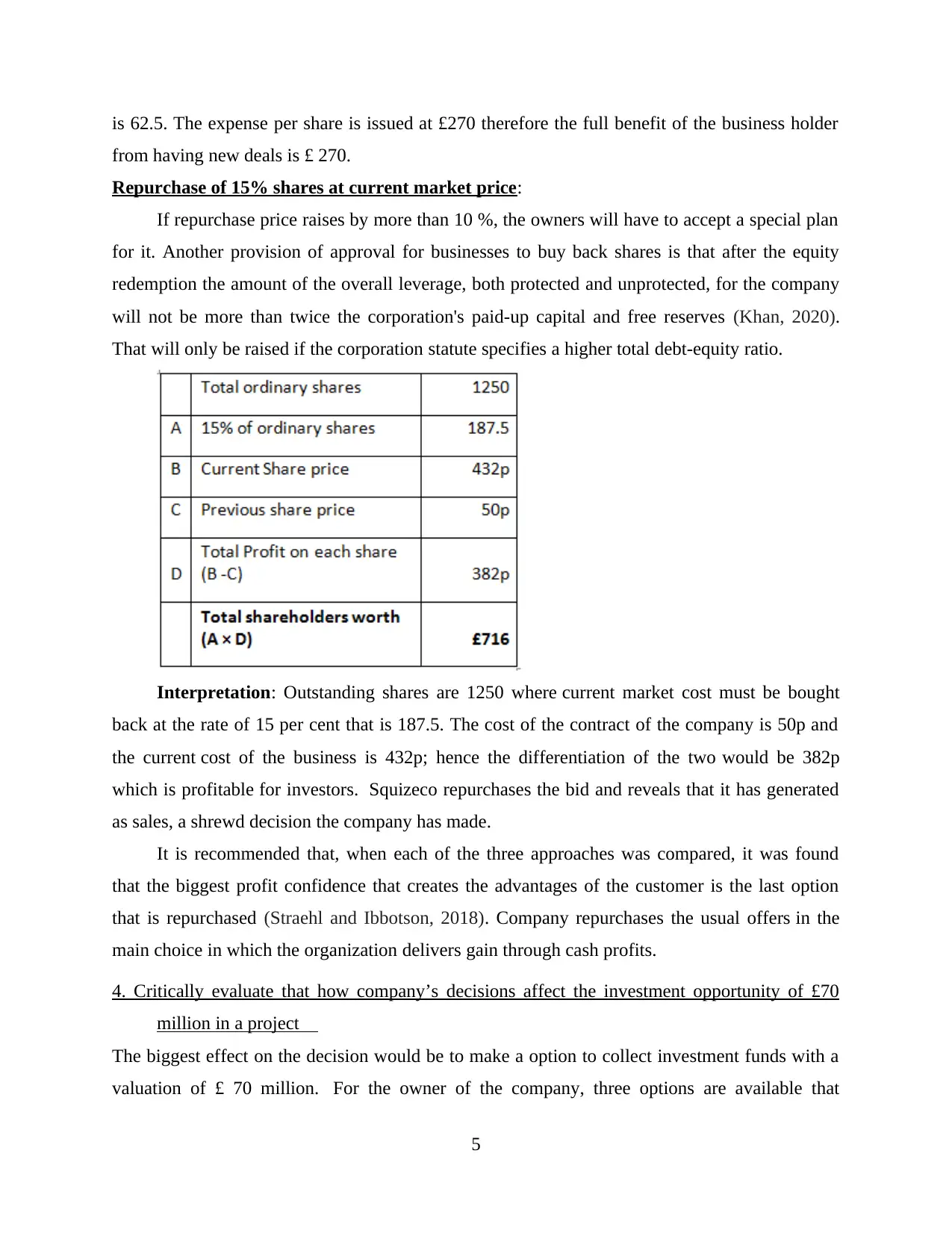
is 62.5. The expense per share is issued at £270 therefore the full benefit of the business holder
from having new deals is £ 270.
Repurchase of 15% shares at current market price:
If repurchase price raises by more than 10 %, the owners will have to accept a special plan
for it. Another provision of approval for businesses to buy back shares is that after the equity
redemption the amount of the overall leverage, both protected and unprotected, for the company
will not be more than twice the corporation's paid-up capital and free reserves (Khan, 2020).
That will only be raised if the corporation statute specifies a higher total debt-equity ratio.
Interpretation: Outstanding shares are 1250 where current market cost must be bought
back at the rate of 15 per cent that is 187.5. The cost of the contract of the company is 50p and
the current cost of the business is 432p; hence the differentiation of the two would be 382p
which is profitable for investors. Squizeco repurchases the bid and reveals that it has generated
as sales, a shrewd decision the company has made.
It is recommended that, when each of the three approaches was compared, it was found
that the biggest profit confidence that creates the advantages of the customer is the last option
that is repurchased (Straehl and Ibbotson, 2018). Company repurchases the usual offers in the
main choice in which the organization delivers gain through cash profits.
4. Critically evaluate that how company’s decisions affect the investment opportunity of £70
million in a project
The biggest effect on the decision would be to make a option to collect investment funds with a
valuation of £ 70 million. For the owner of the company, three options are available that
5
from having new deals is £ 270.
Repurchase of 15% shares at current market price:
If repurchase price raises by more than 10 %, the owners will have to accept a special plan
for it. Another provision of approval for businesses to buy back shares is that after the equity
redemption the amount of the overall leverage, both protected and unprotected, for the company
will not be more than twice the corporation's paid-up capital and free reserves (Khan, 2020).
That will only be raised if the corporation statute specifies a higher total debt-equity ratio.
Interpretation: Outstanding shares are 1250 where current market cost must be bought
back at the rate of 15 per cent that is 187.5. The cost of the contract of the company is 50p and
the current cost of the business is 432p; hence the differentiation of the two would be 382p
which is profitable for investors. Squizeco repurchases the bid and reveals that it has generated
as sales, a shrewd decision the company has made.
It is recommended that, when each of the three approaches was compared, it was found
that the biggest profit confidence that creates the advantages of the customer is the last option
that is repurchased (Straehl and Ibbotson, 2018). Company repurchases the usual offers in the
main choice in which the organization delivers gain through cash profits.
4. Critically evaluate that how company’s decisions affect the investment opportunity of £70
million in a project
The biggest effect on the decision would be to make a option to collect investment funds with a
valuation of £ 70 million. For the owner of the company, three options are available that
5
Paraphrase This Document
Need a fresh take? Get an instant paraphrase of this document with our AI Paraphraser
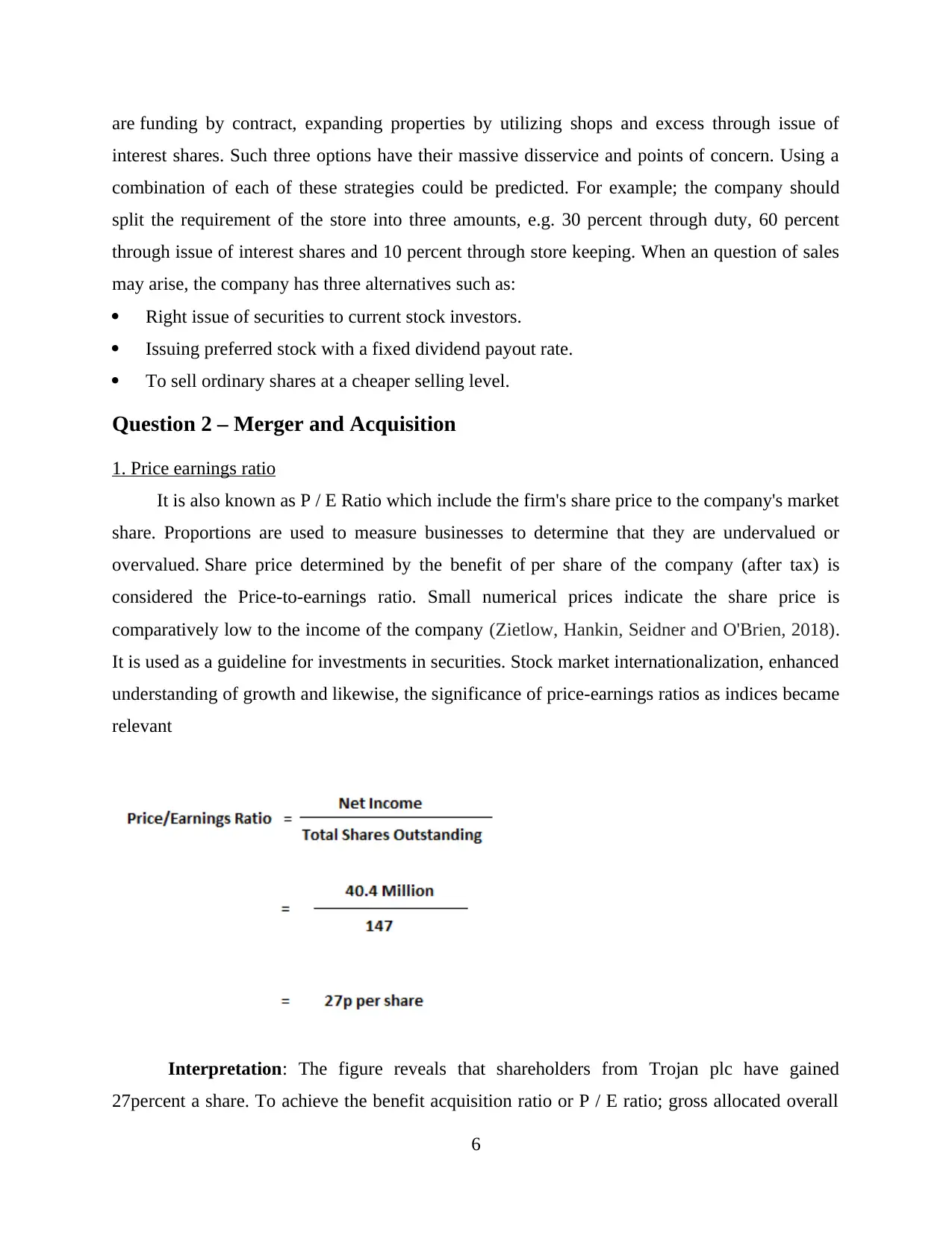
are funding by contract, expanding properties by utilizing shops and excess through issue of
interest shares. Such three options have their massive disservice and points of concern. Using a
combination of each of these strategies could be predicted. For example; the company should
split the requirement of the store into three amounts, e.g. 30 percent through duty, 60 percent
through issue of interest shares and 10 percent through store keeping. When an question of sales
may arise, the company has three alternatives such as:
Right issue of securities to current stock investors.
Issuing preferred stock with a fixed dividend payout rate.
To sell ordinary shares at a cheaper selling level.
Question 2 – Merger and Acquisition
1. Price earnings ratio
It is also known as P / E Ratio which include the firm's share price to the company's market
share. Proportions are used to measure businesses to determine that they are undervalued or
overvalued. Share price determined by the benefit of per share of the company (after tax) is
considered the Price-to-earnings ratio. Small numerical prices indicate the share price is
comparatively low to the income of the company (Zietlow, Hankin, Seidner and O'Brien, 2018).
It is used as a guideline for investments in securities. Stock market internationalization, enhanced
understanding of growth and likewise, the significance of price-earnings ratios as indices became
relevant
Interpretation: The figure reveals that shareholders from Trojan plc have gained
27percent a share. To achieve the benefit acquisition ratio or P / E ratio; gross allocated overall
6
interest shares. Such three options have their massive disservice and points of concern. Using a
combination of each of these strategies could be predicted. For example; the company should
split the requirement of the store into three amounts, e.g. 30 percent through duty, 60 percent
through issue of interest shares and 10 percent through store keeping. When an question of sales
may arise, the company has three alternatives such as:
Right issue of securities to current stock investors.
Issuing preferred stock with a fixed dividend payout rate.
To sell ordinary shares at a cheaper selling level.
Question 2 – Merger and Acquisition
1. Price earnings ratio
It is also known as P / E Ratio which include the firm's share price to the company's market
share. Proportions are used to measure businesses to determine that they are undervalued or
overvalued. Share price determined by the benefit of per share of the company (after tax) is
considered the Price-to-earnings ratio. Small numerical prices indicate the share price is
comparatively low to the income of the company (Zietlow, Hankin, Seidner and O'Brien, 2018).
It is used as a guideline for investments in securities. Stock market internationalization, enhanced
understanding of growth and likewise, the significance of price-earnings ratios as indices became
relevant
Interpretation: The figure reveals that shareholders from Trojan plc have gained
27percent a share. To achieve the benefit acquisition ratio or P / E ratio; gross allocated overall
6
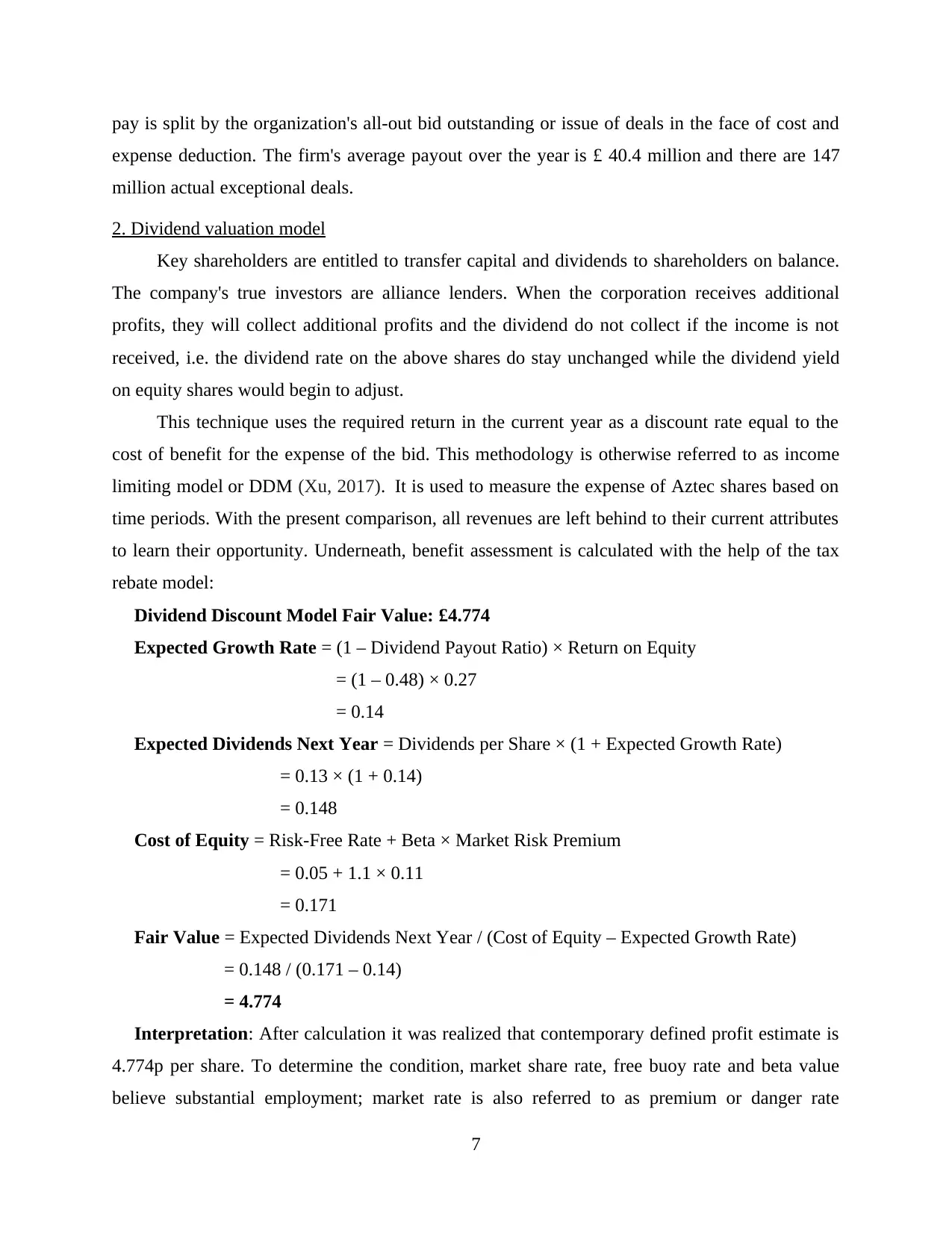
pay is split by the organization's all-out bid outstanding or issue of deals in the face of cost and
expense deduction. The firm's average payout over the year is £ 40.4 million and there are 147
million actual exceptional deals.
2. Dividend valuation model
Key shareholders are entitled to transfer capital and dividends to shareholders on balance.
The company's true investors are alliance lenders. When the corporation receives additional
profits, they will collect additional profits and the dividend do not collect if the income is not
received, i.e. the dividend rate on the above shares do stay unchanged while the dividend yield
on equity shares would begin to adjust.
This technique uses the required return in the current year as a discount rate equal to the
cost of benefit for the expense of the bid. This methodology is otherwise referred to as income
limiting model or DDM (Xu, 2017). It is used to measure the expense of Aztec shares based on
time periods. With the present comparison, all revenues are left behind to their current attributes
to learn their opportunity. Underneath, benefit assessment is calculated with the help of the tax
rebate model:
Dividend Discount Model Fair Value: £4.774
Expected Growth Rate = (1 – Dividend Payout Ratio) × Return on Equity
= (1 – 0.48) × 0.27
= 0.14
Expected Dividends Next Year = Dividends per Share × (1 + Expected Growth Rate)
= 0.13 × (1 + 0.14)
= 0.148
Cost of Equity = Risk-Free Rate + Beta × Market Risk Premium
= 0.05 + 1.1 × 0.11
= 0.171
Fair Value = Expected Dividends Next Year / (Cost of Equity – Expected Growth Rate)
= 0.148 / (0.171 – 0.14)
= 4.774
Interpretation: After calculation it was realized that contemporary defined profit estimate is
4.774p per share. To determine the condition, market share rate, free buoy rate and beta value
believe substantial employment; market rate is also referred to as premium or danger rate
7
expense deduction. The firm's average payout over the year is £ 40.4 million and there are 147
million actual exceptional deals.
2. Dividend valuation model
Key shareholders are entitled to transfer capital and dividends to shareholders on balance.
The company's true investors are alliance lenders. When the corporation receives additional
profits, they will collect additional profits and the dividend do not collect if the income is not
received, i.e. the dividend rate on the above shares do stay unchanged while the dividend yield
on equity shares would begin to adjust.
This technique uses the required return in the current year as a discount rate equal to the
cost of benefit for the expense of the bid. This methodology is otherwise referred to as income
limiting model or DDM (Xu, 2017). It is used to measure the expense of Aztec shares based on
time periods. With the present comparison, all revenues are left behind to their current attributes
to learn their opportunity. Underneath, benefit assessment is calculated with the help of the tax
rebate model:
Dividend Discount Model Fair Value: £4.774
Expected Growth Rate = (1 – Dividend Payout Ratio) × Return on Equity
= (1 – 0.48) × 0.27
= 0.14
Expected Dividends Next Year = Dividends per Share × (1 + Expected Growth Rate)
= 0.13 × (1 + 0.14)
= 0.148
Cost of Equity = Risk-Free Rate + Beta × Market Risk Premium
= 0.05 + 1.1 × 0.11
= 0.171
Fair Value = Expected Dividends Next Year / (Cost of Equity – Expected Growth Rate)
= 0.148 / (0.171 – 0.14)
= 4.774
Interpretation: After calculation it was realized that contemporary defined profit estimate is
4.774p per share. To determine the condition, market share rate, free buoy rate and beta value
believe substantial employment; market rate is also referred to as premium or danger rate
7

because conjecture takes this additional premium to experience challenge. Though free buoy
levels are not risky because there would be no risk of losing the value of the company.
3. Discounted cash flow method
Discounted cash flow (DCF) is known as an estimation tool which is used to measure an
investment's worth on a basis of its potential cash flows. DCF analysis tries to determine worth
of today’s investment on a basis of estimations of that how much money will it be able to
produce in future (Zhang, Li and Ren, 2016). This appears to apply to investors' capital assets
and also to company owners seeking to make adjustments in their businesses, such as acquiring
new technology or buying new equipment.
Discounted cash flow method
Year Net Income £m Discounted cash flow @7%
Year 1 40.40 37.76
Year 2 41.21 35.99
Year 3 42.03 34.31
Year 4 42.87 32.71
Year 5 43.73 31.18
171.95
Interpretation: From the above calculation of small distributed pay profits with an
average growth rate of 2 percent per annum, it is established that after completion of 5 years
from its investment a company will get £ 171.95m at a present value.
4. Discuss the problems which associated with valuation model
Following discussed are some of the issues while calculating a value of an investment using
above valuation methods:
1. It could not be used while investing in stocks in order to determine a stock that does not
yield dividends, irrespective of capital gains. DDM is based on a faulty premise; it says that a
share's sole value is return on investment which is generated by dividends.
2. Another limitation is a fact that it uses number of estimations about issues like rate of
growth and expected rate of return which are included in calculation of price. An example of this
is when dividend yields shift dramatically over time (Shakeel and Datta, 2020). If one of
its assumptions or estimations made in calculation is substantially in error, it could result in an
analyst, who calculates value for stock, being undervalued or upgraded considerably. Closed
8
levels are not risky because there would be no risk of losing the value of the company.
3. Discounted cash flow method
Discounted cash flow (DCF) is known as an estimation tool which is used to measure an
investment's worth on a basis of its potential cash flows. DCF analysis tries to determine worth
of today’s investment on a basis of estimations of that how much money will it be able to
produce in future (Zhang, Li and Ren, 2016). This appears to apply to investors' capital assets
and also to company owners seeking to make adjustments in their businesses, such as acquiring
new technology or buying new equipment.
Discounted cash flow method
Year Net Income £m Discounted cash flow @7%
Year 1 40.40 37.76
Year 2 41.21 35.99
Year 3 42.03 34.31
Year 4 42.87 32.71
Year 5 43.73 31.18
171.95
Interpretation: From the above calculation of small distributed pay profits with an
average growth rate of 2 percent per annum, it is established that after completion of 5 years
from its investment a company will get £ 171.95m at a present value.
4. Discuss the problems which associated with valuation model
Following discussed are some of the issues while calculating a value of an investment using
above valuation methods:
1. It could not be used while investing in stocks in order to determine a stock that does not
yield dividends, irrespective of capital gains. DDM is based on a faulty premise; it says that a
share's sole value is return on investment which is generated by dividends.
2. Another limitation is a fact that it uses number of estimations about issues like rate of
growth and expected rate of return which are included in calculation of price. An example of this
is when dividend yields shift dramatically over time (Shakeel and Datta, 2020). If one of
its assumptions or estimations made in calculation is substantially in error, it could result in an
analyst, who calculates value for stock, being undervalued or upgraded considerably. Closed
8
Secure Best Marks with AI Grader
Need help grading? Try our AI Grader for instant feedback on your assignments.
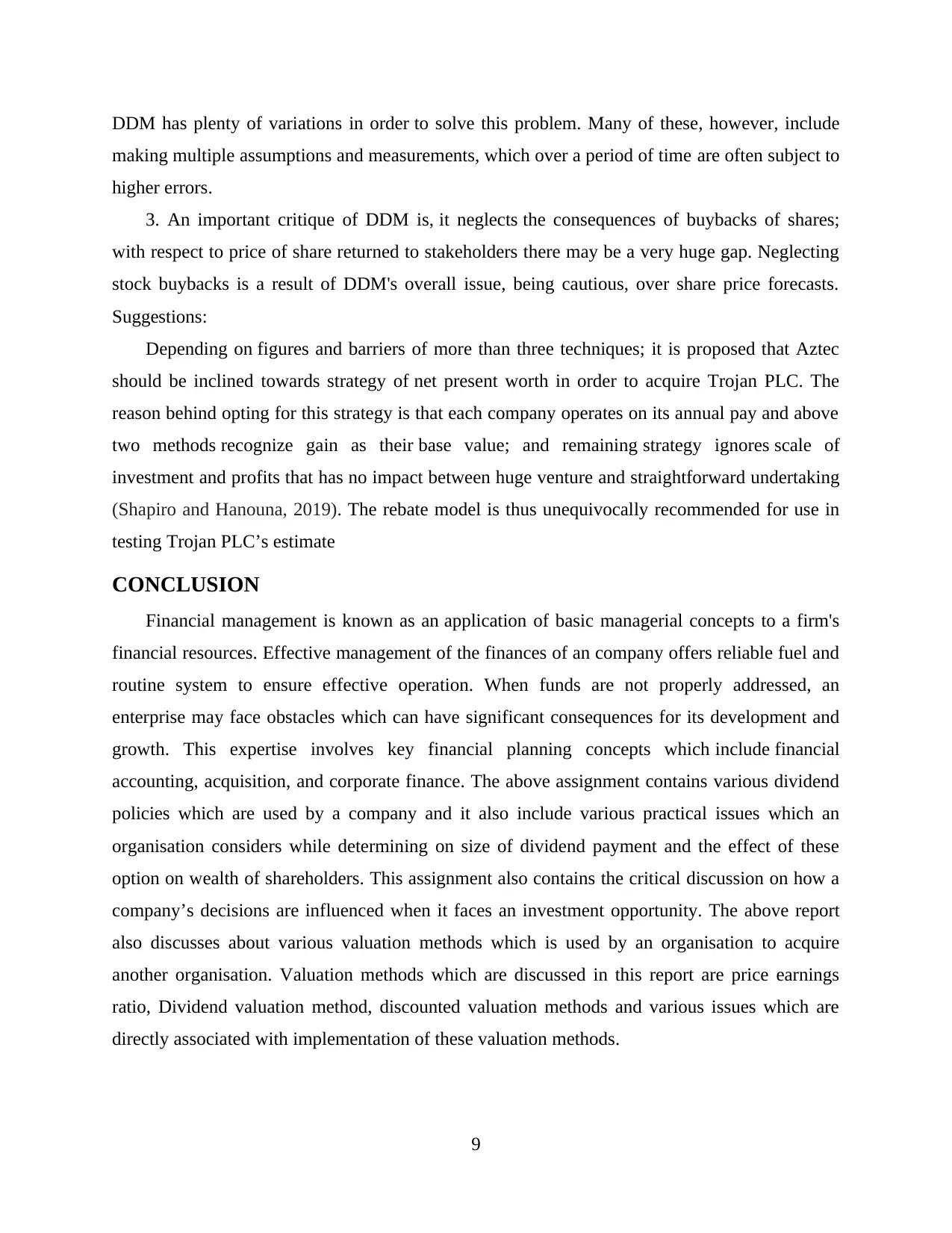
DDM has plenty of variations in order to solve this problem. Many of these, however, include
making multiple assumptions and measurements, which over a period of time are often subject to
higher errors.
3. An important critique of DDM is, it neglects the consequences of buybacks of shares;
with respect to price of share returned to stakeholders there may be a very huge gap. Neglecting
stock buybacks is a result of DDM's overall issue, being cautious, over share price forecasts.
Suggestions:
Depending on figures and barriers of more than three techniques; it is proposed that Aztec
should be inclined towards strategy of net present worth in order to acquire Trojan PLC. The
reason behind opting for this strategy is that each company operates on its annual pay and above
two methods recognize gain as their base value; and remaining strategy ignores scale of
investment and profits that has no impact between huge venture and straightforward undertaking
(Shapiro and Hanouna, 2019). The rebate model is thus unequivocally recommended for use in
testing Trojan PLC’s estimate
CONCLUSION
Financial management is known as an application of basic managerial concepts to a firm's
financial resources. Effective management of the finances of an company offers reliable fuel and
routine system to ensure effective operation. When funds are not properly addressed, an
enterprise may face obstacles which can have significant consequences for its development and
growth. This expertise involves key financial planning concepts which include financial
accounting, acquisition, and corporate finance. The above assignment contains various dividend
policies which are used by a company and it also include various practical issues which an
organisation considers while determining on size of dividend payment and the effect of these
option on wealth of shareholders. This assignment also contains the critical discussion on how a
company’s decisions are influenced when it faces an investment opportunity. The above report
also discusses about various valuation methods which is used by an organisation to acquire
another organisation. Valuation methods which are discussed in this report are price earnings
ratio, Dividend valuation method, discounted valuation methods and various issues which are
directly associated with implementation of these valuation methods.
9
making multiple assumptions and measurements, which over a period of time are often subject to
higher errors.
3. An important critique of DDM is, it neglects the consequences of buybacks of shares;
with respect to price of share returned to stakeholders there may be a very huge gap. Neglecting
stock buybacks is a result of DDM's overall issue, being cautious, over share price forecasts.
Suggestions:
Depending on figures and barriers of more than three techniques; it is proposed that Aztec
should be inclined towards strategy of net present worth in order to acquire Trojan PLC. The
reason behind opting for this strategy is that each company operates on its annual pay and above
two methods recognize gain as their base value; and remaining strategy ignores scale of
investment and profits that has no impact between huge venture and straightforward undertaking
(Shapiro and Hanouna, 2019). The rebate model is thus unequivocally recommended for use in
testing Trojan PLC’s estimate
CONCLUSION
Financial management is known as an application of basic managerial concepts to a firm's
financial resources. Effective management of the finances of an company offers reliable fuel and
routine system to ensure effective operation. When funds are not properly addressed, an
enterprise may face obstacles which can have significant consequences for its development and
growth. This expertise involves key financial planning concepts which include financial
accounting, acquisition, and corporate finance. The above assignment contains various dividend
policies which are used by a company and it also include various practical issues which an
organisation considers while determining on size of dividend payment and the effect of these
option on wealth of shareholders. This assignment also contains the critical discussion on how a
company’s decisions are influenced when it faces an investment opportunity. The above report
also discusses about various valuation methods which is used by an organisation to acquire
another organisation. Valuation methods which are discussed in this report are price earnings
ratio, Dividend valuation method, discounted valuation methods and various issues which are
directly associated with implementation of these valuation methods.
9

REFERENCES
Books & Journals
Anthony, M.U.G.O., 2019. Effects of merger and acquisition on financial performance: case
study of commercial banks. International Journal of Business Management and
Finance, 1(1).
Greve, H.R. and Man Zhang, C., 2017. Institutional logics and power sources: Merger and
acquisition decisions. Academy of Management Journal, 60(2), pp.671-694.
Buchanan, B.G., Cao, C.X., Liljeblom, E. and Weihrich, S., 2017. Uncertainty and firm dividend
policy—A natural experiment. Journal of Corporate Finance, 42, pp.179-197.
Ehrhardt, M.C. and Brigham, E.F., 2016. Corporate finance: A focused approach. Cengage
learning.
Renneboog, L. and Szilagyi, P.G., 2020. How relevant is dividend policy under low shareholder
protection?. Journal of International Financial Markets, Institutions and Money, 64,
p.100776.
He, W., Ng, L., Zaiats, N. and Zhang, B., 2017. Dividend policy and earnings management
across countries. Journal of Corporate Finance, 42, pp.267-286.
Moortgat, L., Annaert, J. and Deloof, M., 2017. Investor protection, taxation and dividend
policy: long-run evidence, 1838–2012. Journal of Banking & Finance, 85, pp.113-
131.
Setiawan, D., Bandi, B., Phua, L.K. and Trinugroho, I., 2016. Ownership structure and dividend
policy in Indonesia. Journal of Asia Business Studies.
Khan, F., 2020. Does Dividend Policy Determine Stock Price Volatility?(A Case Study of
Malaysian Manufacturing Sector). Journal Global Policy and Governance, 9(1),
pp.67-78.
Straehl, P.U. and Ibbotson, R.G., 2018. “The Long-Run Drivers of Stock Returns: Total Payouts
and the Real Economy”: Author Response. Financial Analysts Journal, 74(1).
Zietlow, J., Hankin, J.A., Seidner, A. and O'Brien, T., 2018. Financial management for nonprofit
organizations: policies and practices. John Wiley & Sons.
Xu, J., 2017. Growing through the merger and acquisition. Journal of Economic Dynamics and
Control, 80, pp.54-74.
Zhang, C., Li, D. and Ren, R., 2016. Pythagorean fuzzy multigranulation rough set over two
universes and its applications in merger and acquisition. International Journal of
Intelligent Systems, 31(9), pp.921-943.
Shakeel, S. and Datta, S., 2020. Role of Internal Audit in Merger and Acquisition. The
Management Accountant Journal, 55(4), pp.40-45.
Shapiro, A.C. and Hanouna, P., 2019. Multinational financial management. Wiley.
10
Books & Journals
Anthony, M.U.G.O., 2019. Effects of merger and acquisition on financial performance: case
study of commercial banks. International Journal of Business Management and
Finance, 1(1).
Greve, H.R. and Man Zhang, C., 2017. Institutional logics and power sources: Merger and
acquisition decisions. Academy of Management Journal, 60(2), pp.671-694.
Buchanan, B.G., Cao, C.X., Liljeblom, E. and Weihrich, S., 2017. Uncertainty and firm dividend
policy—A natural experiment. Journal of Corporate Finance, 42, pp.179-197.
Ehrhardt, M.C. and Brigham, E.F., 2016. Corporate finance: A focused approach. Cengage
learning.
Renneboog, L. and Szilagyi, P.G., 2020. How relevant is dividend policy under low shareholder
protection?. Journal of International Financial Markets, Institutions and Money, 64,
p.100776.
He, W., Ng, L., Zaiats, N. and Zhang, B., 2017. Dividend policy and earnings management
across countries. Journal of Corporate Finance, 42, pp.267-286.
Moortgat, L., Annaert, J. and Deloof, M., 2017. Investor protection, taxation and dividend
policy: long-run evidence, 1838–2012. Journal of Banking & Finance, 85, pp.113-
131.
Setiawan, D., Bandi, B., Phua, L.K. and Trinugroho, I., 2016. Ownership structure and dividend
policy in Indonesia. Journal of Asia Business Studies.
Khan, F., 2020. Does Dividend Policy Determine Stock Price Volatility?(A Case Study of
Malaysian Manufacturing Sector). Journal Global Policy and Governance, 9(1),
pp.67-78.
Straehl, P.U. and Ibbotson, R.G., 2018. “The Long-Run Drivers of Stock Returns: Total Payouts
and the Real Economy”: Author Response. Financial Analysts Journal, 74(1).
Zietlow, J., Hankin, J.A., Seidner, A. and O'Brien, T., 2018. Financial management for nonprofit
organizations: policies and practices. John Wiley & Sons.
Xu, J., 2017. Growing through the merger and acquisition. Journal of Economic Dynamics and
Control, 80, pp.54-74.
Zhang, C., Li, D. and Ren, R., 2016. Pythagorean fuzzy multigranulation rough set over two
universes and its applications in merger and acquisition. International Journal of
Intelligent Systems, 31(9), pp.921-943.
Shakeel, S. and Datta, S., 2020. Role of Internal Audit in Merger and Acquisition. The
Management Accountant Journal, 55(4), pp.40-45.
Shapiro, A.C. and Hanouna, P., 2019. Multinational financial management. Wiley.
10
1 out of 12
Related Documents
Your All-in-One AI-Powered Toolkit for Academic Success.
+13062052269
info@desklib.com
Available 24*7 on WhatsApp / Email
![[object Object]](/_next/static/media/star-bottom.7253800d.svg)
Unlock your academic potential
© 2024 | Zucol Services PVT LTD | All rights reserved.





